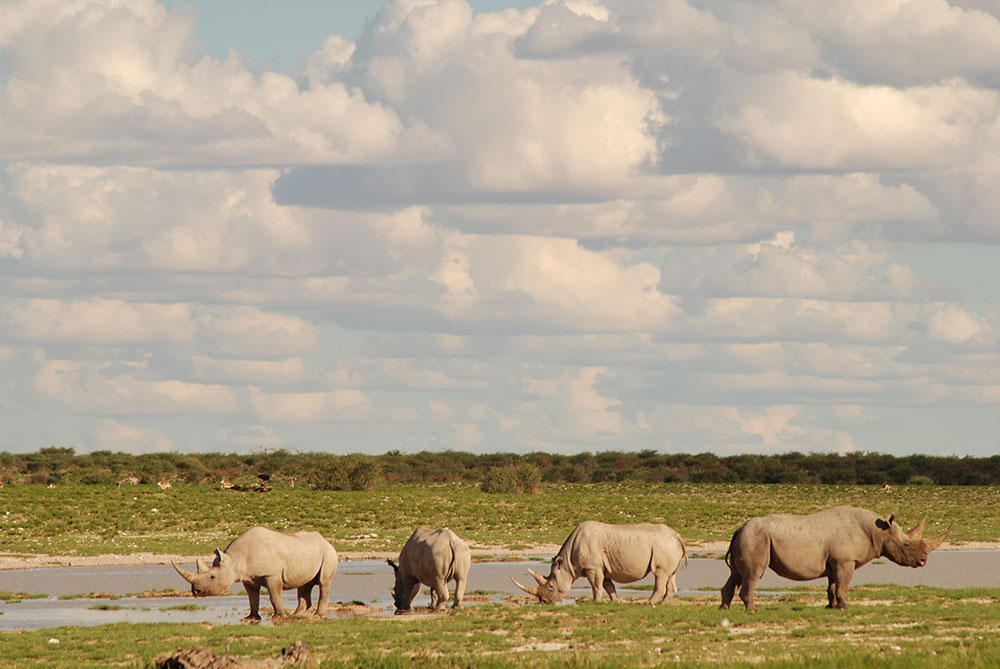
Black rhinos at a pan in central Namibia. Despite their reputation as solitary animals, black rhinos enjoy socializing around water sources. Author’s photo
April 2, 2020 | By Birgit Kötting
In 1993, one nation set out to conserve an iconic species; 27 years later, its success deserves note.
Namibia’s vision for its black rhinoceros is that by 2030 Diceros bicornis bicornis will be re-established in viable, healthy breeding populations throughout its former range; and that it will be sustainably utilized through photo tourism and conservation hunting. One of the strategic objectives of Vision 2030 is to establish black rhinos across all three of Namiibia’s land-tenure systems—state-protected areas, communal conservancies and private freeholds—in order to use all available vacant habitat.
Sparked by Vision 2030, after careful planning and preparation Namibia’s Black Rhino Custodianship Program officially kicked off on April 14, 1993, when the first six animals were translocated to a freehold farm under a Memorandum of Understanding signed by the farmer and MET, the Ministry of Environment and Tourism. Later that year, on July 29, five more black rhinos were moved to a second freehold farm. At the time, the two farms had a combined area of 29,300 hectares (72,400 acres). The rhinos came from national parks, as Namibia has no zoo rhinos. All black rhinos in Namibia are state-owned; white rhinos are not part of the custodianship program because they can be privately owned.
The concept of the Black Rhino Custodianship Program is that breeding nuclei of the animals be relocated as free-ranging populations to suitable habitat on farmland and communal conservancies where the landholders are willing and able to undertake the responsibility of providing basic care and security to them.
Other prerequisites for the BRC Program are that the applicant must be a bona fide landowner; the property must be appropriately fenced for black rhino; the property must be at least 10,000 hectares (24,710 acres) and financially sound; and the applicant must be willing to enter into a Memorandum of Understanding with the Ministry of Environment and Tourism.
The MoU covers aspects such as ownership of the animals (black rhinos in Namibia remain state property, even progeny born on custodian or conservancy lands) as well as their care. (MET provides veterinary care and the Protected Resources Division of the Namibian Police assists with security.) Custodians must monitor and oversee their populations, provide food and water and keep the rhinos safe to the best of their ability. Custodians also must report births, mortalities, animals that have not been seen for a while, animals that are sick or in poor condition, etc. in addition, the MoU addresses research and filming, the sale or enlargement of the property, genetic management of the population and indemnity from civil liability.
All applicants to receive black rhinos undergo a detailed assessment; major considerations include the size of the property, its habitat (topography, drought potential, browse variety and abundance, soil deficiencies, competition from other browsers), water (number and type of water points, distribution, quality and availability of natural perennial or seasonal water), security (fence quality, risks from proximity to roads, towns and borders, the prevalence of poaching and the attitude of the neighbors), the potential for disturbance (nearby mining, roads, capture of wildlife, hunting, proximity to airports) and the risk of disease. Also considered are the owner’s anti-poaching capacity (monitoring, patrolling, gate control, neighborhood watch, radio communications, aerial support, vetting of staff), management skills (knowledge and experience, continuity, presence, attitude) and experience with other specially protected species (introduction success, monitoring, safekeeping).
Exceptions to some of these prerequisites may be allowed under certain conditions—for example, rhinos may be put into areas smaller than 10,000 hectares or, with careful planning, rhinos may be released into unfenced areas.
After assessment by senior MET officials and the Protected Resources Division of the Namibian Police, properties and compared and weighted according to a score card. In the past, security was not weighted heavily as there had been little or no rhino poaching in Namibia and neighboring countries. With the onslaught of poaching, however, the score card was revised, and the importance of security and anti-poaching measures adjusted.
The first communal conservancy officially joined the BRCP in April 2004, when four animals were introduced into a fenced core area. From 2006 onward, several other conservancies, all in the remote Kunene region of northwest Namibia, have joined the program and taken in rhinos from the free-roaming Kunene population.
In 2009, MET made a bold move by establishing two rhino populations in much more arid southern Namibia—one group at the Fish River and one at the Orange River. A previous attempt to re-introduce black rhinos to the south, in Naute Game Park, had failed, which led to a reluctance to translocate black rhinos south of Windhoek. Not only was there great concern over such re-introductions, but this was a formidable undertaking in general, as the habitat there is so different from that of any donor population and the animals had to go through lengthy boma (corral) training in Etosha national Park as well as at the receiving farms.
Boma training means conditioning captive rhinos to, among other things, the food plants of the area into which they will be released. In southern Namibia, this required a huge amount of logistical support and commitment from both MET and the custodians, who made significant contributions by building bomas on their properties at their own cost and paying for the transport of the animals, as well as providing staff and tractors and other equipment to look after the rhinos in the bomas.
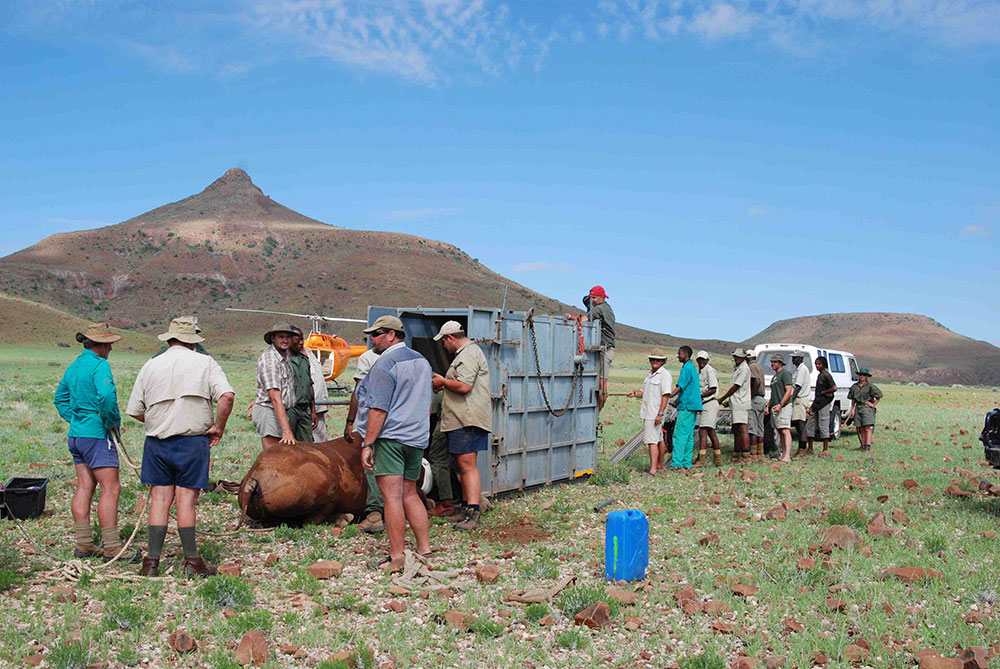
Loading a black rhino for translocation to a conservancy. Author’s photo

A black rhino in boma training. Author’s photo
The Fish River rhinos have not done as well, but today the black rhino population at the Orange River is hugely successful, having increased to 11 animals from four (two bulls and two cows). Although most of them came from Etosha National Park, where there are virtually no euphorbia plants, all these animals learned to eat the toxic euphorbias of southern Namibia and are managing astonishingly well in this arid habitat.
(The Euphorbia genus is widespread throughout the world; in Namibia, several species occur, of which the best known is probably Euphorbia damarana, a shrub in northwest Namibia, which black rhino love to eat. In far southern Namibia, a similar-looking but different euphorbia occurs, Euphorbia gregaria. Its milky latex can be an irritant—and in other species even toxic or lethal—but animals can adapt to certain toxic plants, and these two Euphorbia species are browsed by kudu and giraffe as well as black rhino. Black rhino may uproot the entire plant to get the stem and root, leaving their bodies streaked with white latex. People use the latex, leaves and bark of several Euphorbia for fish poison and to repel insects, but eating food exposed to euphorbia smoke—when cooked on an open fire—can result in headaches, nausea and even death.)
Drought has to be taken seriously, especially in habitat that is already so marginal. About six years of below-average rainfall in the far south of Namibia caused the animals at the Orange River property to lose considerable condition, and the cow-calf combinations especially suffered tremendously. The animals are currently being offered supplementary feed and their condition has improved significantly. An advantage of boma training is that rhinos can become accustomed to eating lucerne (alfalfa) and so, in years of drought, take to it more easily than animals that have undergone vend-to-veld translocation and are not familiar with lucerne.

Orange River black rhino cow and calf in very poor condition before supplementary feed was provided. Author’s photo
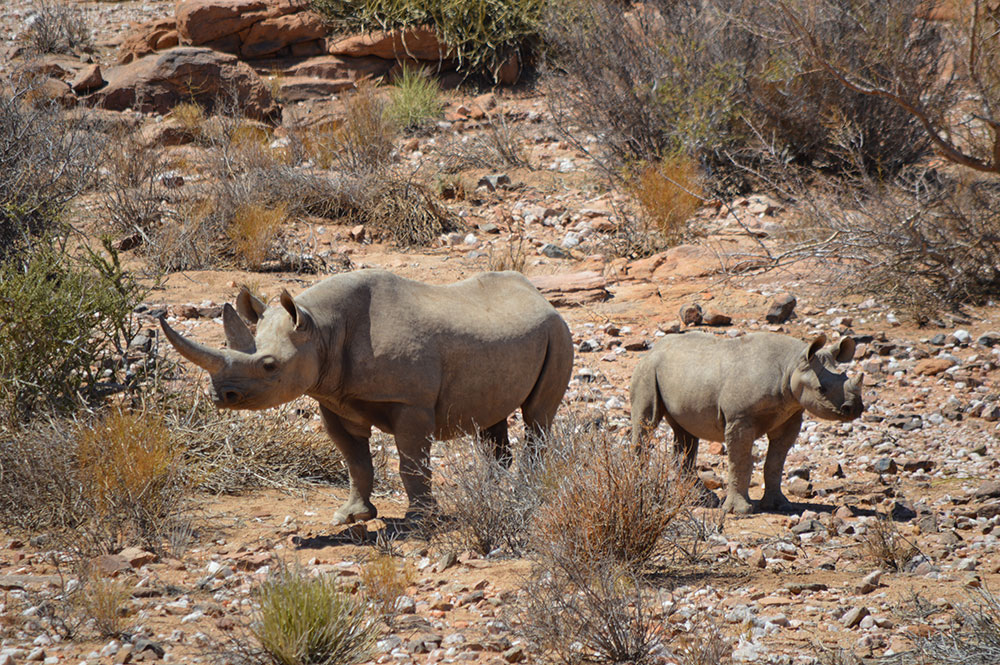
Orange River black rhino cow and calf in very good condition after about two months of feeding on lucerne (alfalfa). Author’s photo
In 2010, MET tried to relocate black rhinos to communal conservancies in the arid extreme northwest of Namibia, but these attempts failed, likely because of the competition from community livestock around water points, which caused the rhinos to wander in search of less disturbance.
Today, 27 years after the first animals were translocated, 35 land units are part of the Black Rhino Custodianship program—25 commercial farms or game ranches and 10 communal conservancies. The 25 freehold custodians, plus one core area in a conservancy, cover an area of 769,000 hectares (1.97 million acres) and the nine Kunene conservancies cover a combined area of 2,674,100 hectares (6.61 million acres). The custodianship program presently hosts an estimated 560 black rhinos on freehold land and a further 150 in conservancies.
Over the years, nine freehold custodians and one communal custodian have exited the program for various reasons, resulting in a loss of more than 85,000 hectares (210,000 acres) of prime habitat for rhino conservation in the private sector, which potentially could have accommodated more than 150 rhinos. The impact of habitat loss on conservation remains a threat of immeasurable magnitude, and it is no different for the black rhinoceros. Losing custodians should therefore be avoided at all costs, if possible. Remarkably, and regrettably, no financial support was ever available to assist custodians, even in providing security, which is very costly. This is testimony to the commitment to conservation of the participants in the program.
For metapopulation management objectives, DNA samples and other information is used to assess the degree of relatedness among the individual populations and the need to move animals around among the different populations. For many years, the aggregate black rhino population in Namibia’s custodianship scheme outperformed all other black rhino populations in Africa in breeding success and rate of increase.
This can be attributed to several factors (among others): Generally, young cows, which are only coming into breeding age, are involved; and when breeding commences, it is at optimal levels, with short inter-calving periods and high calf survival rates. Typically, a sex ratio of 1:1 is introduced and when bulls are involved, one is older (to take on the role of breeding) and the others are of pre-breeding age, which initially reduces social pressures of competition and dominance. As well, founder populations are relatively small, to initiate rapid growth, and prime habitat is selected.
As the individual populations increased, the rate of growth was expected to slow down, and this has indeed occurred. Nonetheless, the custodianship rhino populations in aggregate continue to increase at a near-optimal rate. The long-term average growth rate for the custodian metapopulation—that is, our 560 black rhinos on custodial properties—stands at 8.7%, from 1994 to 2019.
The 150 animals in conservancies are excluded from the calculation as they are in extremely arid areas and are thus affected badly by drought, so their population growth is the lowest in the country. Still, we have already achieved Vision 2030, as we currently have just over 2,000 black rhinos in Namibia, with approximately 1,500 in the rest of the country (at Etosha National Park and other smaller parks). Namibia now holds more than 90% of the world’s wild black rhinos.
In 2017, the growth rate across the program was 8.1%; however, with the drastic increase in poaching on custodian properties from 2018 on, the growth rate dropped to 7.6% in 2018 and 7.2% in 2019. In contrast, the Namibian national growth rate for black rhino before poaching was 6%. Although at 7.2%, the growth rate is still far higher than for any other black rhino population in Namibia (and possibly in the entire southern African range), the sharp decline in the past two years is a huge concern.
Previously, due to a sudden escalation of rhino poaching in northwestern Namibia, MET decided in 2014 to dehorn all state-owned rhinos. Since 2016, a total of 182 rhinos have been dehorned on 18 custodian properties, and many more in the national parks. Dehorning is the removal of horns under anesthesia; it is the horns that are of value to poachers. (This is a temporary measure, as horns regrow.)
Dehorning reaches far beyond just removing an animal’s horn for security—such operations help audit numbers, sex and age structures. As well, unmarked animals are ear-notched, which makes monitoring easier and more accurate, and all individuals are DNA-sampled, which can assist with forensic investigations when a rhino carcass is found or horns are confiscated.
The challenge in this approach is to conduct proactive, rather than reactive, dehorning, to keep up with re-dehorning and backing up dehorning with other counter-poaching measures. Dehorning should therefore not be seen as the only solution to poaching but part of the solution.
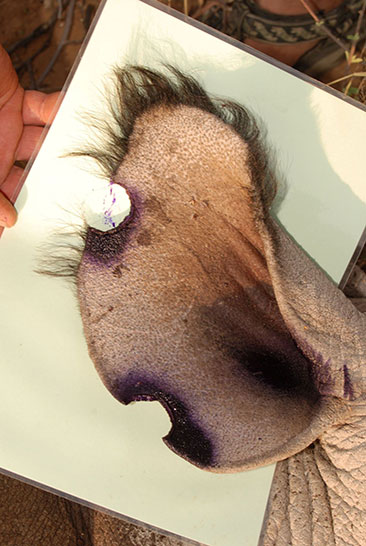
Rhinos are ear-notched for easy visual identification of individuals. Author’s photo
Good monitoring remains the foundation of anti-poaching efforts and is absolutely critical for properties with rhinos—in order to be able to pre-empt threats, one needs to know how many rhinos there are and where they roam. In small populations all individuals can be known, but in larger populations regular aerial counts are made. To identify individual animals, ear-notching is critical. Camera traps are also widely used for monitoring.
Effective security for rhinos requires a combination of methods such as foot, vehicle, aerial and horse patrols, cameras, dog units, perimeter security technology, threat analyses and training. Cooperation between custodians, MET, the Namibian Police and Defence Force, police reservists, neighborhood watches, security companies and others is critical. Improved information-sharing between stakeholders builds trust and is therefore also critical.
Furthermore, sustainable incentive schemes must be developed and implemented so that custodians can receive direct benefits from “their” rhinos. Options for this are covered under MET’s Black Rhino Management Strategy, and a model has been developed to determine how this could work. Donor funding for this is critical.
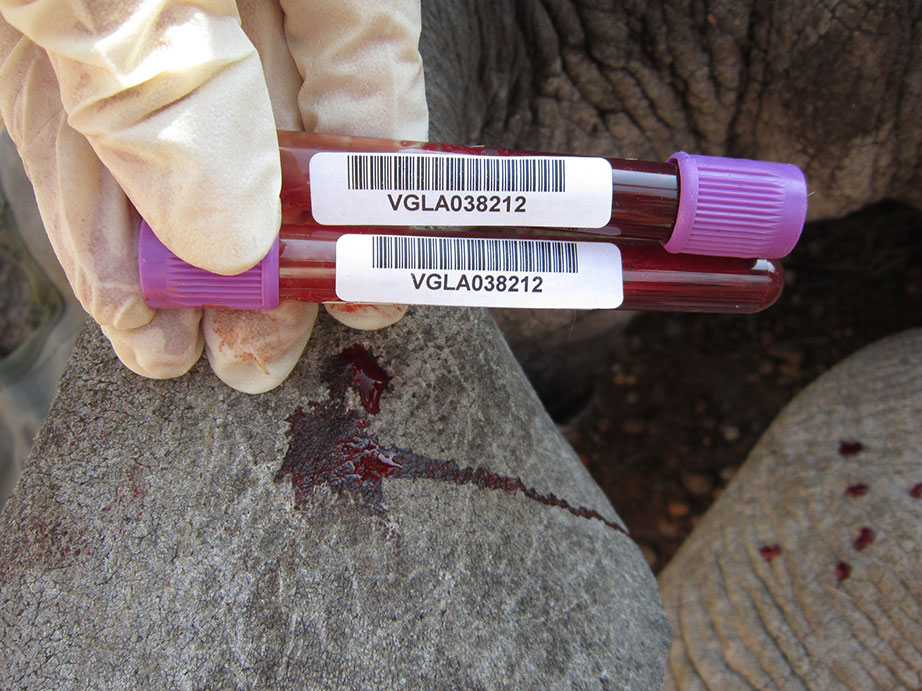
Black rhino blood samples for analysis and a DNA database. Author’s photo
One way to ensure a direct benefit to custodians is via conservation hunting (as trophy hunting is called in Namibia). Old breeding bulls are displaced by younger bulls, who then take over dominance and defend their females against competitors. Often, in such fights for dominance, the older bull is terminally injured. Older bulls in the post-reproductive phase are therefore considered for conservation hunting in order to generate income.
The first instances of conservation hunting of custodianship rhinos have taken place. However, the scale of program costs versus the potential for recovery through hunting is a considerable challenge and other means of creating revenue must be explored as well.
Birgit Kötting is a control warden with MET, Namibia’s Ministry of Environment and Tourism, where she has been employed for 25 years. She has been the Black Rhino Custodianship Program manager since 2006.


